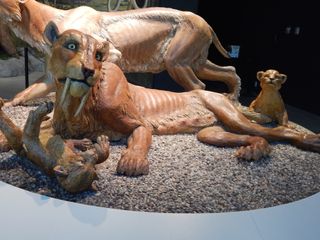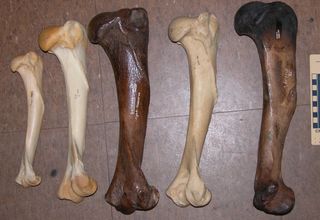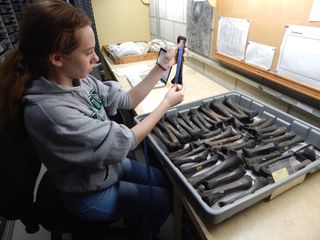This Cat Was Buff: Saber-Toothed Kittens Were Muscly
"The babies start off muscle-bound and then they grow like every other cat," said study co-researcher Donald Prothero, a research associate in the Department of Vertebrate Paleontology at the Natural History Museum of Los Angeles County. [12 Amazing Saber-Toothed Animals]
It's well known among paleontologists that S. fatalis — a now-extinct beast that lived from about 37,000 to 9,000 years ago — had an Arnold Schwarzenegger-like body. The fierce kitty had a broad chest and short, stout limbs, said study lead researcher Katherine Long, a master's student in the Department of Geological Sciences at California State Polytechnic University.
"But we didn't really know too much about their kittens," Long told Live Science. "We just know [that] as adults, they were just really, really muscle-bound."

To investigate, Long measured the length and circumference of about 200 S. fatalis limb bones recovered from the La Brea Tar Pits in Los Angeles, which is an area where asphalt naturally seeps to the surface. The limb bones came from kitties of different ages, so Long was able to create a growth chart of the species, showing how they grew in length and robustness as they aged.
Then, Long and her colleagues compared the saber-toothed cat growth chart with the growth curves of other cat species, including the cougar (Puma concolor), tiger (Panthera tigris), lion (Panthera leo), American cave lion (Panthera atrox), wildcat (Felis silvestris) and serval (Leptailurus serval). An analysis showed that the saber-toothed cat bones were more robust than the Panthera bones, the researchers found.
"It was interesting to see that although we have these really robust, huge [saber-toothed cat] animals, they are still growing just as delicately as a small jungle wildcat," Long said.

The study is a "good start" into discovering how saber-toothed kittens grew, but more work lies ahead, said Julie Meachen, an assistant professor of anatomy and a vertebrate paleontologist at Des Moines University, who was not involved in the research.
Sign up for the Live Science daily newsletter now
Get the world’s most fascinating discoveries delivered straight to your inbox.
For instance, to understand how saber-toothed kitties grew, "you need internal measurements of the bones," Meachen said. This could be done by taking an X-ray or computed tomography (CT) scan of the cats' bones, which would illuminate the size of the bone marrow within. Then, researchers could get a better idea of the true cross-sectional area of the cortical, or hard, bone that was supporting the cats' weight, Meachen said.
"If you take cross-sectional area from just diameter, basically you're modeling the limb as a solid beam, which is not the case at all," Meachen said. "So, it's giving you a false sense of the ability of the bone."
Even so, the findings are a good start for learning about saber-toothed growth, Meachen said. "They basically show that saber-tooth kittens grow like other cats. It's not like they have a weird growth pattern: They just start off bigger, they start off more robust to begin with."

The study was published online today (Sept. 27) in the journal PLOS ONE.
Original article on Live Science.

Laura is the archaeology and Life's Little Mysteries editor at Live Science. She also reports on general science, including paleontology. Her work has appeared in The New York Times, Scholastic, Popular Science and Spectrum, a site on autism research. She has won multiple awards from the Society of Professional Journalists and the Washington Newspaper Publishers Association for her reporting at a weekly newspaper near Seattle. Laura holds a bachelor's degree in English literature and psychology from Washington University in St. Louis and a master's degree in science writing from NYU.
Most Popular



